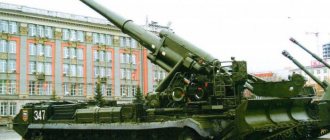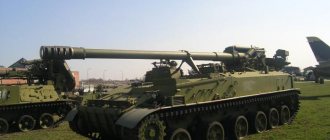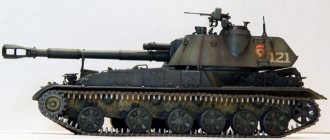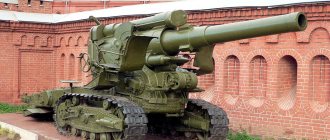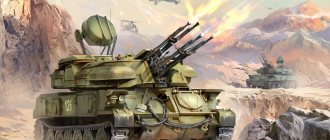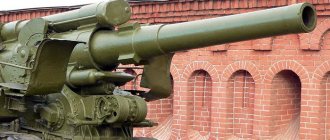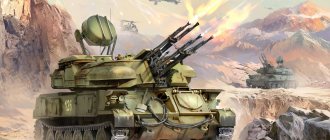Artillery classes
Beginning in the fourteenth century, European armies began to use artillery. Mortars at that time became the most powerful class of weapons. Even their very ominous name (derived from the Dutch mortier, which in turn borrowed the Latin root mort - “death”) indicated high lethal efficiency. Next in descending order was the howitzer, the technical characteristics of which (projectile weight and range) were somewhat inferior to those of the mortar. The cannon (canon) was considered the most common and mobile class. The calibers were different, but that was not the only reason. The main feature of the class of guns was the design of the barrel, which determined their purpose. Based on the structure of the artillery of the army of a particular state, even then it was possible to draw conclusions about the strategic plans and military doctrine of its government.
Tactical and technical characteristics of the D-30A howitzer
— Entered into service: 1963 - Manufacturer: Plant No. 9, PMZ (2A18 for SAO 2S1)
Calculation: 6 people
Projectile speed D-30A
— Initial speed of a high-explosive fragmentation projectile (full charge): 690 m/s — Initial speed of a high-explosive fragmentation projectile (reduced variable charge): 270–565 m/s — Initial speed of a cumulative projectile: 740 m/s
— Maximum pressure of powder gases: 250 MPa — Weight of high-explosive fragmentation projectile: 21.76 kg — Weight of cumulative projectile: 14 kg — Weight of charge (full): 4 kg
Firing range of D-30A
— Longest firing range: 15.4 km
Overall dimensions D-30A
— Barrel length with muzzle brake (without pivot beam): 4.66 m (38klb) — Barrel length without muzzle brake: 4.3 m (35klb) — Length of the rifled part: 3.4 m — Howitzer length in stowed position: 5 .4 m — Width of the howitzer in the stowed position: 2.2 m — Height of the howitzer in the stowed position (excluding lights): 1.8 m — Height of the line of fire: 0.9 m — Length of the howitzer in the firing position at an elevation angle of 0° : 7.8 m — Distance between the support points of the carriage in the firing position: 5.6 m — Ground clearance (minimum): 0.325 m
— Number of rifling: 36 — Highest elevation angle: 70° — Lowest declination angle: −7° — Horizontal firing at a barrel elevation angle from −5° to 18°: 360° — Horizontal firing at an elevation angle from +18° to 70° and when the barrel is positioned between the movable frames: 66° - Horizontal fire at an elevation angle from +18° to 70° and when the barrel is positioned between the fixed and movable frames: ±29° - The amount of Steol M liquid in the brake of the recoil parts: 10, 3 l - Amount of Steol M liquid in the knurl: 9.7 l - Amount of Steol M liquid in the balancing mechanism: 0.45 l - Initial pressure in the knurl: 4.6 MPa - Normal rollback length: 0.74-0.93 m — Pressure in the balancing mechanism: 6MPa
Weight D-30A
— Howitzer in combat position: 3200 kg. — Howitzer in traveling position: 3290 kg. — Barrel: 1.05 t — Shutter: 30 kg — Swinging part: 1.5 t — Recoiling part: 1.23 t — Cradle: 210 kg — Brake of recoil parts assembled: 75 kg — Upper machine: 212 kg — Lower machine with fixed bed: 318 kg - Beds (two): 310 kg - Knurl assembled: 73 kg - Wheels with hub: 148 kg - Ski rig: 270 kg
Rate of fire D-30A
— Howitzer rate of fire: 6-8 rounds/min — Time to transfer from traveling to combat position: 1.5-2.5 min
— Highest transportation speed: 80 km/h
Ancient stone throwers
Actually, siege devices - the distant ancestors of artillery pieces - helped attacking warriors capture castles and fortresses long before the mass use of gunpowder began. In catapults and ballistas, to impart initial speed to projectiles (and these were usually stones, containers with boiling resin, large steles or logs), the elastic properties of stretchable ropes were used, into which metal wire was woven during manufacture. The momentum accumulated during twisting was released at the moment the special lock was released. It was then that the word “howitzer” arose. The technical characteristics of the “stone-throwing machine” (this is how the word Haubitz is translated from German) were very modest, they fired at a couple of tens of meters and produced more of a psychological effect, although under certain conditions and good training in calculations they could well cause a fire (if the projectile was incendiary) . Advances in the field of lethal devices have led to an increased role for remote weapons.
Howitzer caliber
The tasks of modern howitzer artillery have gone far beyond the previously outlined circle. The projectile's projectile trajectory is good not only for hitting manpower hidden in trenches and dugouts, but also for other purposes. Fortified areas are often protected by a thick layer of reinforced concrete and dug deep into the ground. The frontal armor of tanks and other armored vehicles can withstand the impact of many armor-piercing weapons, while at the same time it has more vulnerable spots on top. If a conventional gun achieves high accuracy due to the high initial velocity of the projectile, then one of the conditions for achieving the last parameter is the relatively low weight of this very projectile. A large caliber is what distinguishes a howitzer from a cannon. This class of guns requires 100mm shells, and there are also larger ones.
Shield and sword
Russian howitzers are an indispensable component of the country’s artillery and missile shield. Their offensive purpose does not indicate the aggressiveness of the military doctrine, but not a single army in the world excludes the possibility of attacking or delivering preemptive strikes, right? In addition, few types of artillery have undergone such significant changes and universalization of functionality as the howitzer. The technical characteristics of this weapon make it possible to use it for firing along a flat trajectory, that is, to use it for defense, including anti-tank.
And gunpowder must always be kept dry.
Production
Production was organized simultaneously on two and "Barricades"). The greatest difficulties arose on. In 1933, this plant presented only one howitzer for delivery, but it could not be delivered until the end of the year. The first two B-4 howitzers were delivered in the 1st half of 1934. In 1940, the Novokramatorsky plant was involved in production, which was set an annual plan of 25 howitzers, while for the plant in Stalingrad it was 10 times larger.
Working drawings of the howitzer were changed at each plant, adapting to technological capabilities.
As a result, practically two different howitzers began to enter service. In 1937, unified drawings were worked out not by changing the design, but by assembling individual parts and assemblies that had already been tested in production and operation. The only innovation was that it was mounted on a caterpillar track, which allowed firing directly from the ground without special platforms. But complete unification of production howitzers and “Barricade” was not achieved. Serial production of B-4 howitzers
| Manufacturer | 1933 | 1934 | 1935 | 1936 | 1937 | 1938 | 1939 | 1940 | 1941 | 1942 | Total |
| Bolshevik/No. 232 (Leningrad) | 19 | 60 | 13 | 12 | 42 | 49 | 48 | 243 | |||
| Barricades/No. 221 (Stalingrad) | 15 | 75 | 181 | 165 | 300 | 3 | 739 | ||||
| NKZ (Kramatorsk) | 3 | 26 | 29 | ||||||||
| Total | 19 | 75 | 13 | 12 | 42 | 124 | 229 | 168 | 326 | 3 | 1011 |
Production of B-4 howitzers in 1941
| Manufacturer | 1st half of the year | July | August | September | October | Total |
| Barricades/No. 221 (Stalingrad) | 210 | 30 | 30 | 21 | 9 | 300 |
| NKZ (Kramatorsk) | 11 | 5 | 5 | 5 | 26 | |
| Total | 221 | 35 | 35 | 26 | 9 | 326 |
In total, from 1933 to 1942, 1011 B-4 howitzers were produced, of which 31 were low-power.
Brigades, regiments, divisions armed with B-4
Shelves
- 108th High Power Howitzer Artillery Regiment
- 110th high-power howitzer artillery regiment named after. K. E. Voroshilova
- 137th High Power Howitzer Artillery Regiment
- 318th High Power Howitzer Artillery Regiment
- 330th high-power howitzer artillery regiment (46 B-4s as of 06/22/1941)
- 400th High Power Howitzer Artillery Regiment
- 402nd High Power Howitzer Artillery Regiment
- 403rd High Power Howitzer Artillery Regiment
- 406th High Power Howitzer Artillery Regiment
- 409th High Power Howitzer Artillery Regiment
- 420th High Power Howitzer Artillery Regiment
- 515th High Power Howitzer Artillery Regiment
- 519th High Power Howitzer Artillery Regiment
- 529th High Power Howitzer Artillery Regiment
- 229th corps heavy artillery regiment (one division) (from 1936 to 1939 - 56th corps heavy artillery regiment of high power)
Brigades
- 101st howitzer artillery Vladimir-Volynsk Order of Bohdan Khmelnitsky II degree high-power brigade of the RGK.
- 103rd howitzer artillery order of Suvorov II degree high-power brigade of the RGK.
- 104th howitzer artillery Prague Red Banner Order of Suvorov II degree high-power brigade of the RGK. Formed in April 1943. Commander - since September 1944, Colonel Solomienko Pavel Mamontovich. In 1944 it was given the honorary name Prague for the capture of the Warsaw suburb of Prague. She was awarded the Order of the Red Banner in March 1945 for breaking through enemy defenses on a bridgehead on the Vistula River. Awarded in 1945 the Order of Suvorov, 2nd degree, for the destruction of the enemy southeast of Berlin.
- 105th howitzer artillery Sivash Red Banner Order of Kutuzov II degree high-power brigade of the RGK. Formed in April 1943 on the basis of the 1021st and 1154th howitzer artillery regiments. Commander - since November 1943, Colonel Lupakov Nikolai Fedorovich (wounded in battle on February 12, 1945, died of wounds on February 25, 1945). In 1944, it was given the honorary name Sivashskaya and awarded the Order of the Red Banner for the liberation of Crimea. Participated in the capture of Zaporozhye and Szekesfehervar. Awarded on April 5, 1945, the Order of Kutuzov, 2nd degree, for the capture of Budapest.
- 107th howitzer artillery brigade of the Order of Alexander Nevsky of high power. In August 1945, she took part in the war with Japan as part of the 5th Army of the 1st Far Eastern Front.
- 108th howitzer artillery Tarnopol Red Banner Order of Kutuzov II degree and Bogdan Khmelnitsky high-power brigade of the RGK.
- 109th Howitzer Artillery Budapest High Power Brigade RGK.
- 112th howitzer artillery Elbing Red Banner Order of Kutuzov II degree high-power brigade RGK. Formed in 1944. Commanders - since March 1945, Colonel Georgy Petrovich Kuleshov, Lieutenant Colonel Semyonov. Kursk region. The brigade had 13 howitzers, formed in June 1943 on the basis of the 318th and 1022nd howitzer artillery regiments. The honorary name Elbing was awarded for the capture of Elbing. Participated in the capture of Danzig.
- 120th howitzer artillery Grudzyand Red Banner Order of Suvorov II degree and Kutuzov II degree high-power brigade of the RGK.
- 121st howitzer artillery Novgorod Red Banner Order of Suvorov II degree, Kutuzov II degree and Alexander Nevsky high-power brigade of the RGK. Formed in 1943 on the basis of the 430th and 1197th howitzer artillery regiments. Commander - since January 1944, Colonel Vasily Petrovich Solovyov. Given the honorary name Novgorod in 1944 for the capture of Novgorod. Participated in the capture of Grudziadz and Danzig.
- 124th howitzer artillery Prague Order of Bohdan Khmelnitsky high-power brigade of the RGK. Formed in 1943 on the basis of the 350th and 1150th howitzer artillery regiments. Commanders - from September 1943, Colonel Lyaske Georgy Konstantinovich and (from September 1944) Colonel Gutin Grigory Lvovich. In 1944, the honorary name Prague was awarded for the capture of the Warsaw suburb of Prague. She took part in the capture of Novorossiysk, Küstrin and the storming of the Reichstag.
- 163rd howitzer artillery order of Kutuzov, II degree, high-power brigade of the RGK. Formed in 1944. Commander - since January 1945, Colonel Rakovich Stanislav Vladislavovich. Awarded in 1945 the Order of Kutuzov, 2nd degree, for the capture of the city and fortress of Glogau. Participated in the capture of the city of Khmilnik.
SU-152
The next step taken by Soviet designers towards creating the most advanced self-propelled guns was the SU-152. It served as a kind of response to the appearance of powerfully armored German tanks, equipped with long-barreled guns, allowing them to fire at our vehicles from long distances (a kilometer or more). The surest way to destroy a well-protected target was to cover it with a heavy projectile flying along a suspended parabolic trajectory. A 152 mm howitzer of ML-20 caliber, mounted on a tank (KV) chassis with a fixed wheelhouse and equipped with rotation mechanisms, turned out to be a means capable of solving this problem.
"Acacia"
The howitzer, developed in the mid to late sixties, entered service in 1970. It can shoot at a distance of 20-30 km (depending on modification). The vehicle itself is quite light, weighing much less than an average tank, which was achieved by reducing the weight of the armor. Direct fire is also possible, but the main purpose remains the same - remotely hitting targets. The chassis is made according to a front-engine design, which proved its worth back in the war years. The design took into account the experience of creating the SAU-100, and the incentive for the reminiscence was the presence of the Americans' M-109 gun, capable of firing a low-power nuclear tactical charge (TNT equivalent of 100 tons). The answer was “Acacia” - a howitzer with no worse characteristics.
In what cases and what to shoot from?
If we assume that the enemy is trying to take possession of the positions of any army, then an attack should be expected from him. Tanks and infantry, supported by attack aircraft, will rush to the previously shelled fortified area. In response, the defending side will use countermeasures and fire from its own artillery and small arms. But if an attack is expected, then appropriate field fortifications will be first erected, full-profile trenches will be dug, bunkers and bunkers will be built, the firing sectors of which will make it difficult to clear the defense zone. In general, each side will do everything to complicate the enemy’s actions. In this situation, fire on defending units buried in the ground can only be conducted along a trajectory called a canopy. Flat (that is, almost parallel to the horizon) shooting will be ineffective: enemy soldiers are securely hidden behind parapets and other defensive structures. An ordinary gun will be almost useless. A howitzer, the characteristics of which are mounted, will help “smoke out” the defenders from trenches and dugouts, raining shells on their heads directly from the sky. The guns are fired by those who are defending themselves. They need to destroy as many enemy tanks and soldiers running towards the positions as possible. They are trying to repel the attack.

